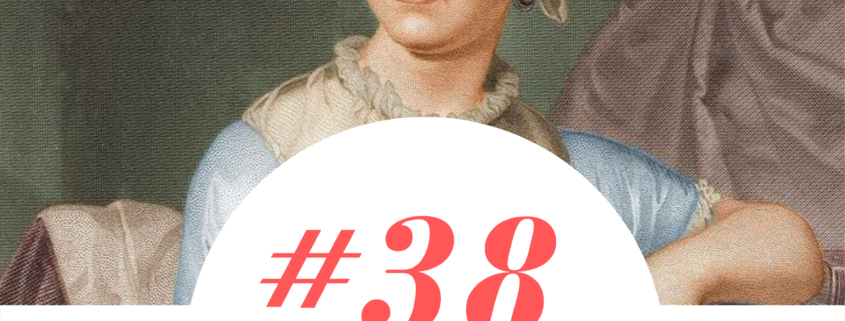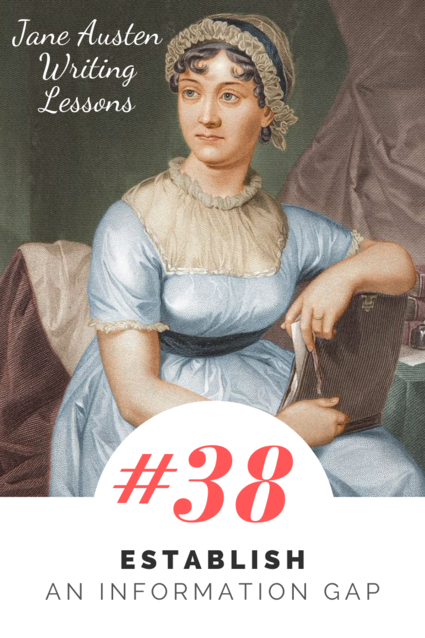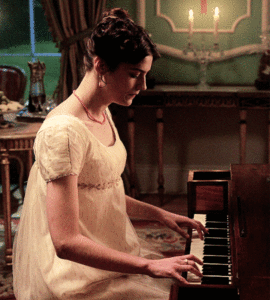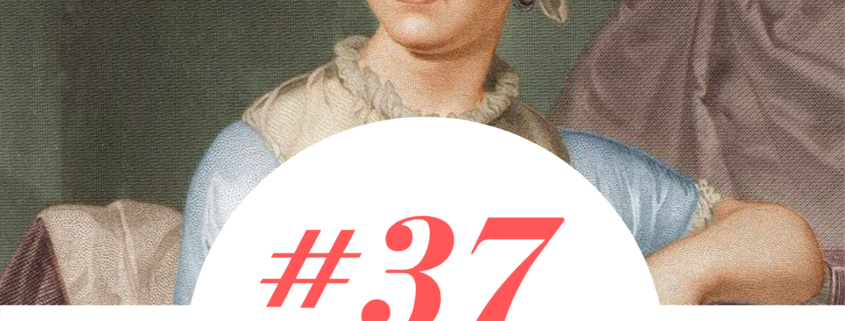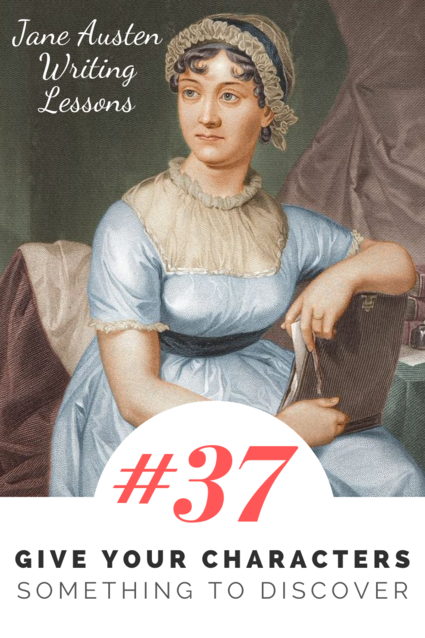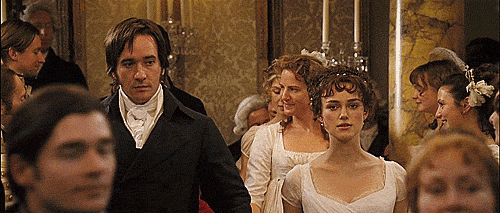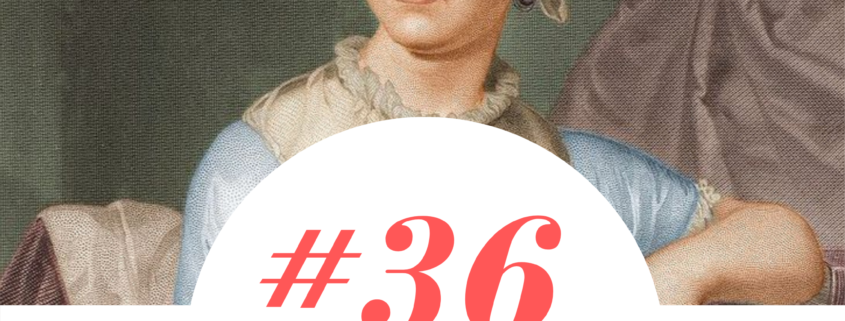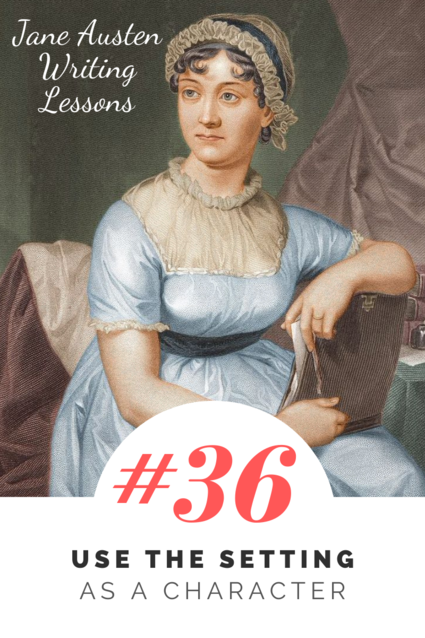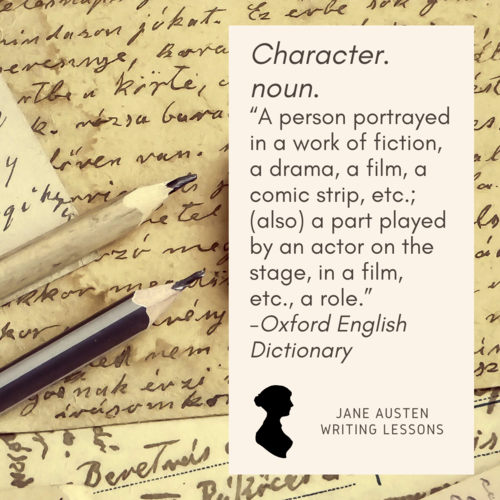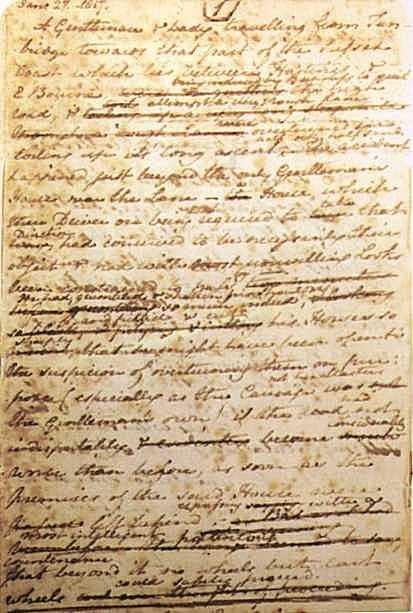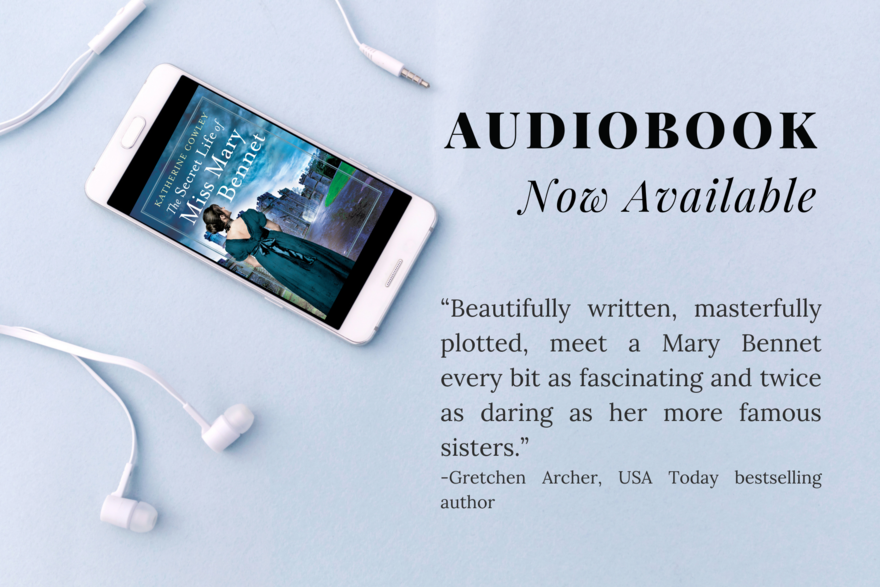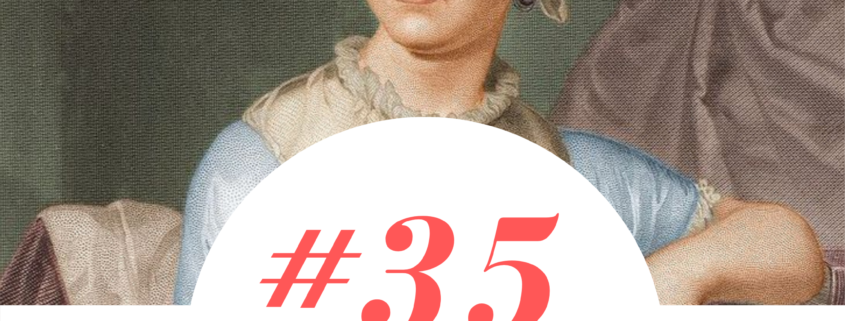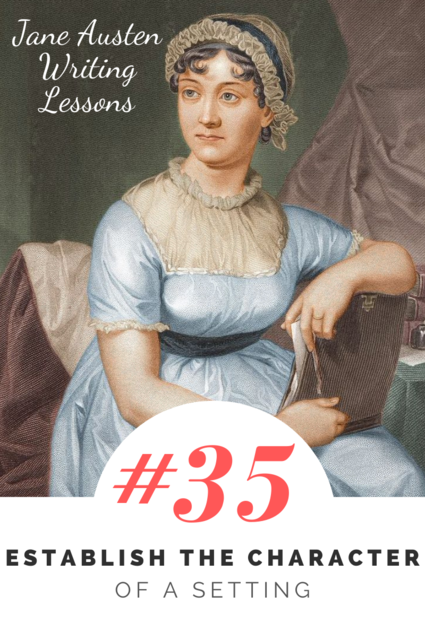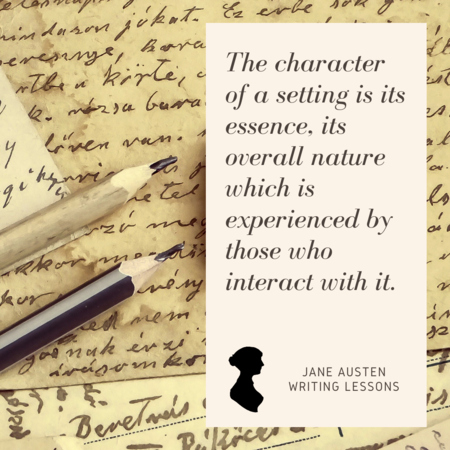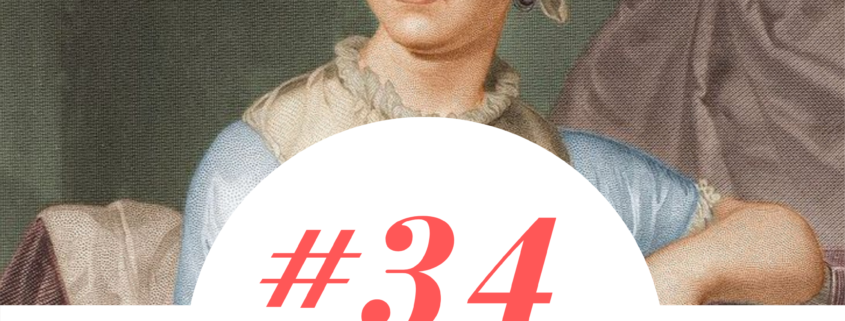#38: Establish an Information Gap
In the last lesson, I talked about the importance of giving your character something to discover—this creates curiosity in the reader and a desire to continue reading the narrative. In order to establish this curiosity about discovery, writers create an information gap for both the characters and the readers. As George Loewenstein explained, an information gap is a gap “between what we know and what we want to know.”
But how, as writers, do we create this information gap? How do we make readers aware of the gap between what they know and what they want to know?
1. Establish an Information Gap by Using Character Anticipation
One of the simplest ways to establish an information gap is to show the characters anticipating something, in their thoughts and words and actions. If the characters desire to know something, then not only do readers learn about this desire, but they begin to develop this desire also.
In Emma, almost all the characters anticipate meeting Frank Churchill and learning what he is like, which creates an awareness of him for the reader, as well as a knowledge that we do not know his character. Coming to know him is established as something intrinsically interesting:
Mr. Frank Churchill was one of the boasts of Highbury, and a lively curiosity to see him prevailed, though the compliment was so little returned that he had never been there in his life. His coming to visit his father had been often talked of but never achieved.
2. Establish an Information Gap by Breaking a Pattern
The human brain relies on patterns to make sense of the world. The book Made to Stick: Why Some Ideas Survive and Others Dies explains that our attention is drawn when a pattern is broken.
There are many “patterns” in Emma, and many of these are related to societal expectations. First, we expect that someone will meet there verbal and written commitments. Mr. Churchill commits to come to Highbury to visit his father, but then he does not. This breaks a pattern:
“Where is the young man?” said John Knightley. “Has he been here on this occasion—or has he not?”
“He has not been here yet,” replied Emma. “There was a strong expectation of his coming soon after the marriage, but it ended in nothing; and I have not heard him mentioned lately.”
There is also a societal expectation that someone will behave in a “proper manner” to family members. This respect and consideration would include visiting them, but Mr. Churchill does not visit.
Any time that a pattern is broken in a story, especially if it is a behavioral pattern, then it creates an information gap: we want to know why this pattern has been broken. Another famous example of breaking a pattern in Emma is when Jane Fairfax receives an unexpected gift from an undisclosed person of a pianoforte. People do not simply receive pianofortes from mysterious benefactors, then or today, and this breaking of a pattern immediately creates an information gap, a mystery that Emma is compelled to unravel.
Gif of Jane Fairfax playing the pianoforte in the 2020 film Emma.
3. Establish an Information Gap by Giving Consequence to Not Finding Out
There are endless things that a character might not know, but we only care about them as readers—they only become actual information gaps for readers—if there is a consequence to not finding out. There must be a reason the characters need to discover something. If there are not consequences to not discovering something, in other words, if the information gap has no stakes, then the character has no reason to fill the information gap, and the reader will not care whether or not they do.
In Emma, we like the character of Mr. Weston and we like his new wife, Mrs. Weston. They are good people, who mean a lot to Emma and to others in the community. And so we care that Mr. Weston’s son, Frank Churchill, refuses to visit.
Yet the stakes are not just for the Westons. Emma’s desire to come to know Mr. Churchill and his character relates to her own personal wants and desires. She is a matchmaker, and she has envisioned a match for herself:
Now, it so happened that in spite of Emma’s resolution of never marrying, there was something in the name, in the idea of Mr. Frank Churchill, which always interested her. She had frequently thought—especially since his father’s marriage with Miss Taylor—that if she were to marry, he was the very person to suit her in age, character and condition. He seemed by this connexion between the families, quite to belong to her. She could not but suppose it to be a match that every body who knew them must think of. That Mr. and Mrs. Weston did think of it, she was very strongly persuaded; and though not meaning to be induced by him, or by any body else, to give up a situation which she believed more replete with good than any she could change it for, she had a great curiosity to see him, a decided intention of finding him pleasant, of being liked by him to a certain degree, and a sort of pleasure in the idea of their being coupled in their friends’ imaginations.
Filling this information gap—coming to know Mr. Churchill and his character—has personal consequences for Emma and her future happiness.
4. Establish an Information Gap by Raising New Questions When Questions are Answered
There is a risk in creating something for your characters to discover: once they have discovered it, why should we keep reading? For big questions, when a question is answered, then a new question is often raised.
In Emma, Frank Churchill does ultimately come to Highbury. We meet him, we see him in front of us. Yet a new question is brought to the fore: what is Frank Churhill’s character? Yes, he has come, but is he the sort of man Emma has expected? Will he meet Emma’s matchmaking expectations and fall in love with her? How will he behavior to various parties now that he is in Highbury? Will there be a ball, and who will he dance with at the ball?
New questions about Frank Churchill are raised with every question that is answered, and in a sense, the larger question that was established before his arrival—what is Frank Churchill’s character?—is never clearly answered. It requires the full novel to answer that question, and each little detail is just one piece of the puzzle.
5. Establish an Information Gap by Revealing Key Information
While it is common to conceal information in order to create an information gap, the reverse can also be done. Revealing key information can actually create an information gap as we become curious about the consequences of this information. This is especially true when what is revealed has the potential to disrupt the forward path of the protagonist.
Austen’s novel Emma relies on concealing information, but her novel Mansfield Park reveals information in order to create a need for discovery.
In Mansfield Park, the main character, Fanny Price, has watched with disapproval as a new neighbor, Henry Crawford, flirts shamelessly with her cousins Maria and Julia, despite the fact that Maria is engaged. Then Maria weds and both her and Julia leave Mansfield Park, and Henry Crawford decides to turn his attentions to Fanny.
At this point, Austen could have created the information gap by simply continuing to show Fanny’s viewpoint. Through Fanny’s eyes, we would begin to see Henry’s attentions to Fanny, and we would wonder at the cause of them. We would wonder if he had changed on a fundamental level, and we would desire to know what both he and Fanny will choose to do as a result of these intentions.
Yet Austen does not follow this storytelling path. Instead, Austen reveals a huge piece of information before Henry begins to pay his attentions to Fanny. Austen provides the following scene between Henry Crawford and his sister Mary:
“And how do you think I mean to amuse myself, Mary, on the days that I do not hunt? I am grown too old to go out more than three times a week; but I have a plan for the intermediate days, and what do you think it is?”
“To walk and ride with me, to be sure.”
“Not exactly, though I shall be happy to do both, but that would be exercise only to my body, and I must take care of my mind. Besides, that would be all recreation and indulgence, without the wholesome alloy of labour, and I do not like to eat the bread of idleness. No, my plan is to make Fanny Price in love with me.”
“Fanny Price! Nonsense! No, no. You ought to be satisfied with her two cousins.”
“But I cannot be satisfied without Fanny Price, without making a small hole in Fanny Price’s heart.”
Providing this key information to the reader actually raises the stakes and raises our curiosity: we know that Mr. Crawford intends to make Fanny fall in love with him simply because he likes playing with women’s hearts and he wants to amuse himself.
We know from the start that his attentions are not genuine, which heightens the information gap because we feel a strong need for Fanny to discover this.
The other questions are still raised: Will Henry Crawford change? Will his affections become genuine? What will Henry Crawford and Fanny decide to do?
In this particular case, the key information is revealed to the reader but not to the protagonist, yet at times the key information which creates an information gap can be revealed to both the reader and to the protagonist.
In Conclusion
The five key techniques Jane Austen uses to create information gaps and a thirst for discovery are:
- Using character anticipation
- Breaking a pattern
- Giving consequence to not finding out
- Raising new questions when questions are answered
- Revealing key information
Each of these is a power tool to create a gap between what the reader and character know, and what the reader and character want to know. These five techniques can be used individually or in combination.
In the next lesson, I’ll talk about the four categories of things that a reader and a character might want to discover.
Exercise 1: Breaking a pattern
Write a brief scene which includes a number of people doing ordinary or expected things in a place (i.e. a grocery store, a sports game, or a family gathering). Quickly establish the normal pattern of behavior, and then have someone break the pattern.
Exercise 2: Set a timer for 5 or 10 minutes. During this time, make a list of as many events, secrets, characteristics, etc. as possible that be something that characters must discover. Once you’re done, categorize each item on the list as one of the following:
H: Information that, at first, should be hidden or only hinted at—the process of discovery is finding out this information.
R: Information that should be revealed early on to the reader and/or to the character. The information gap and the process of discovery comes from the implications of this revelation.
H or R: This information could work equally well as hidden information or revealed information, though doing so would change the direction of the story.
Exercise 3: Find a story where a character is actively trying to discover something and analyze it: When is the information gap set up? What techniques are used to establish the information gap? Are there multiple information gaps?
#37: Give Your Characters Something to Discover
In one of the famous scenes in Pride and Prejudice, Elizabeth and Mr. Darcy dance at Netherfield Ball. After Elizabeth asks him a series of questions, Mr. Darcy says:
“May I ask to what these questions tend?”
“Merely to the illustration of your character,” said she, endeavouring to shake off her gravity. “I am trying to make it out.”
“And what is your success?”
She shook her head. “I do not get on at all. I hear such different accounts of you as puzzle me exceedingly.”
Gif of Elizabeth and Mr. Darcy dancing in the 2005 film Pride and Prejudice
Throughout Pride and Prejudice, Elizabeth attempts to discover Mr. Darcy’s character, through conversations with him, conversations with others (including Mr. Wickham and Miss Bingley), and through observation of his behavior. In a sense, Mr. Darcy’s character is a mystery, and Elizabeth the detective.
While most of Jane Austen’s novels would not be considered mystery novels on the surface (with the exception of Northanger Abbey, which is a Gothic pastiche), every single Jane Austen novel contains mysteries, things big and small which the characters are attempting to discover. And whenever Austen’s characters are on the road to discovery, readers are hungry for discovery as well.
People in general—and readers especially—are curious, and this is why we like mysteries, this is why we like reading about the process of discovery.
Scientific research backs this up, particularly the theory called the information gap of curiosity.
The information gap theory of curiosity
An article in Wired magazine, “The Itch of Curiosity,” provides a good explanation of the information gap:
The information gap theory of curiosity…was first developed by George Loewenstein of Carnegie-Mellon in the early 90s. According to Loewenstein, curiosity is rather simple: It comes when we feel a gap ‘between what we know and what we want to know’. This gap has emotional consequences: it feels like a mental itch, a mosquito bite on the brain. We seek out new knowledge because we that’s how we scratch the itch.
Jane Austen constantly constructs information gaps which provoke the curiosity of readers and keep them turning the pages.
Sometimes these information gaps are small. For example, as Elizabeth arrives at Netherfield Ball, there are a series of information gaps:
- Where is Mr. Wickham?
- Is Mr. Wickham even going to attend the ball?
- What is Mr. Wickham’s real reason for staying away?
And then, the novel has larger information gaps, gaps that take a large portion of the narrative to answer:
- Who is right—Mr. Wickham or Mr. Darcy?
- And what should be done once that knowledge is obtained?
There is also a series of questions which invite discovery about Mr. Bingley:
- What will Mr. Bingley be like?
- Will Mr. Bingley be interested in one of the Bennet daughters?
- Why has Mr. Bingley left?
- Will Jane see Mr. Bingley in London?
- Will Jane and Mr. Bingley find happiness?
In his famous screenwriting book, Story: Substance, Structure, Style, and the Principles of Screenwriting, Robert McKee writes, “Curiosity is the intellectual need to answer questions and close open patterns. Story plays to this universal desire by doing the opposite, posing questions and opening situations.”
Over the coming weeks, we’ll discuss different aspects of incorporating mystery and discovery into fiction of all genres and styles. By following Austen’s example, and creating possibilities for discovery, we can make our stories more compelling and pique readers’ curiosity.
*Note: There’s a great article by scholar Ellen R. Belton titled “Mystery Without Murder: The Detective Plots of Jane Austen.” Belton makes the argument that Austen’s novels are not simply using aspects of mystery and discovery, but are bona fide detective novels—the protagonists are “not investigating criminals, but potential marriage partners.”
Exercise 1: Rush write a short reflection on the following: What is something that makes you curious? When did you first become interested and why? What makes you want to find out more?
Exercise 2: Choose a published story that’s not in the mystery genre. Make a list of examples of information gaps, mysteries, and discoveries within the story.
Exercise 3: Write a scene about a character doing something that is ordinary or routine, such as taking the subway or drinking coffee. The catch? The scene must include an information gap—a mystery, something that must be discovered.
#36: Use the Setting as a Character
In the past few weeks, we’ve talked about a number of concepts related to setting:
- Using description to establish a setting
- Using a distinctive setting for major plot turns
- Using setting to complement or contrast emotion
- Using familiar and invisible settings
- Using unfamiliar settings
- Establishing the character of a setting
Now, for the final post on setting, I want to address one final topic:
Using the setting as a character
I’ve seen some writers claim that every well-written setting is a character, but to me, making this argument is problematic: if every setting is a character, then the words “setting” and “character” cease to be useful—their meanings are conflated and it is more difficult to talk about their very really differences.
In most stories, the setting is not a character. This is true for most of Jane Austen’s work: her settings are interesting and profound, they reflect the character’s emotional states and sometimes the themes of her stories, yet they aren’t characters. Her settings have character, they have flavor, they mean something to the characters, and they impact the plot, but still they are not characters.
One of the Oxford English Dictionary’s definitions is useful in terms of how we use the word “character” in regard to stories:
Character, noun: “A person portrayed in a work of fiction, a drama, a film, a comic strip, etc.; (also) a part played by an actor on the stage, in a film, etc., a role.”
Ultimately, a character is a person, and ultimately, a setting is not.
Yet sometimes, a setting does act the part of a character; sometimes, a setting acts with personhood.
For instance, in “man vs. nature” stories (which includes everything from disaster stories to smaller, more individual stories like Hatchet), the setting does act as a character—but not just any character; here the setting acts as an antagonist, often virulent, actively fighting against the protagonist and their goals.
Yet you don’t have a sinister, oppositional setting for the setting to act as a character in the story.
In order for a setting to be a character it must:
- Play an active part in the story; be an actor.
- Impact multiple plot points throughout the story.
- Carry a larger metaphorical role that is present throughout the narrative, not just in one particular scene or section.
- Be vibrant like a living organism, and have the potential for change.
- Receive the sort of attention from characters that is normally reserved for people.
- Not be a manifestation of a single character or a small group of characters. (For this reason, Rosings would not be a character, because while it is important, it is entirely defined by Lady Catherine de Bourgh.)
A clear example of Jane Austen using setting as a character is in her uncompleted novel Sanditon. Sanditon is a changing, growing sea town that is attempting to grow into a destination, and it acts as a character in the story.
A page from the manuscript of Sanditon
One of the characters, Mr. Parker, describes Sanditon:
“Sanditon itself—everybody has heard of Sanditon,–the favourite spot of all that are to be found along the coast of Sussex;–the most favoured by Nature, and promising to be the most chosen by man.”
He goes on to say:
“Nature had marked it out—had spoken in most intelligible characters—the finest, purest sea breeze on the coast—acknowledged to be so—excellent bathing—find hard sand—deep water ten yards from the shore—no mud—no weeds—no slimy rocks—never was there a place more palpably designed by Nature for the resort of the invalid—the very spot which thousands seemed in need of—the most desirable distance from London!”
The narrator comments:
Sanditon—the success of Sanditon as a small, fashionable bathing place was the object for which he seemed to live….Sanditon was a second wife and four children to him—hardly less dear—and certainly more engrossing.
Sanditon is in a moment of transformation—it is growing, and how it will grow and develop and effect its inhabitants and its visitors is still unclear. The old is being discarded and the new sought for. Mrs. Parker sees the things that have been lost, the things she misses, the advantages of the old Sanditon, while Mr. Parker sees breaking from the past as a good thing:
“And whose very snug-looking place is this?” said Charlotte, as in a sheltered dip within two miles of the sea, they passed close by a moderate-sized house, well fenced and planted, and rich in the garden, orchards and meadows which are the best embellishments of such a dwelling. “It seems to have as many comforts about it as Willingden.”
“Ah!” said Mr. Parker. “This is my old house—the house of my forefathers—the house where I and all my brothers and sisters were born and bred—and where my own three eldest children were born—where Mrs. Parker and I lived till within the last two years—till our new house was finished….
“One other hill brings us to Sanditon—modern Sanditon—a beautiful spot.—Our ancestors, you know, always built in a hole.—Here were we, pent down in this little contracted nook, without air or view, only one mile and three quarters from the noblest expanse of ocean between the South Foreland and the Land’s End, and without having the smallest advantage from it. You will not think I have made a bad exchange when we reach Trafalgar House—which, by the bye, I almost wish I had not named Trafalgar—for Waterloo is more the thing now.”
Yet while Mr. Parker is leading many of the efforts to transform Sanditon, it refuses to be defined by him. It is talked of constantly by others, from Lady Denham to Sir Edward, and many actors have a role in its future, and its future will impact the fates of dozens of characters.
Mr. Parker clings to the idea of Sanditon on a track of forward progress, he holds to his expectations for it:
“Civilization, civilization indeed!….Who would have expected such a sight as a shoemaker’s in old Sanditon!—This is new within the month.”
Yet he cannot control it; it refuses to mold to his desires; it is separate from himself and what he wants for it:
It was emptiness and tranquility on the Terrace, the cliffs, and the sands. The shops were deserted, the straw hats and pendant lace seemed left to their fate both within the house and without, and Mrs. Whitby at the library was sitting in her inner room reading one of her own novels, for want of employment.
It is a place of tension, where even its number and type of inhabitants are outside of anyone’s control:
Mr. Parker could not but feel that the list [of families] was not only without distinction, but less numerous than he had hoped.
Andrew Davies’ television series Sanditon continues Jane Austen’s unfinished story. In the first season, Davies does an excellent job of making Sanditon a character. We see its growing pains, the troubles of the workers, money problems, and, in the final episode of the season, what begins as a minor problem within the setting becomes a major problem for the entire community. In Davies’ adaptation, the setting is constantly an actor in the story and the lives of the other characters.
Exercise 1: Read the article Ten Books Where the Setting is a Character. Find another example of a setting that is also a character. What makes the setting a character? Why is it useful for the story to have this setting as a character?
Exercise 2: Set a timer for twenty or thirty minutes and begin writing a flash fiction story (less than 1000 words) where the setting is a character. You could use your time to outline and develop ideas or to rush write the beginning of the story. If you the like the direction of focus of the story, take additional time to finish writing and revising it.
Exercise 3: Choose three settings that you have experienced in real life (cities, buildings, outdoor regions, etc.) that would make good candidates for being a character in a story. Make a list of each of their distinguishing attributes, and then add a few notes for what it would take for these to not just be a really compelling, cool setting, but also a character in a story.
The Audiobook for The Secret Life of Miss Mary Bennet is Now Available!
I am so thrilled to announce that The Secret Life of Miss Mary Bennet is now available as an audiobook.
The book was produced by Dreamscape, and it is narrated by the incredible, award-winning British actor and audiobook narrator Alison Larkin. One of Larkin’s books is on Audible’s top ten list of Best Author Narrated Audiobooks, and she’s also won an Audiofile Earphones award. Not only that, but she has narrated the complete novels of Jane Austen. She is literally the perfect person to narrate my book.
I am absolutely in love with the audiobook–it’s better than I could have ever imagined. Larkin completely captures each of the characters, whether it’s Mary speaking, Kitty, Mr. Collins, or a newspaper article.
You can listen to a sample of The Secret Life of Miss Mary Bennet audiobook on Soundcloud.
Purchasing the Audiobook
The book is available through Audible. If you don’t have an Audible account, you can get a copy through Libro FM, Chirp Books, Google Play, or Apple Books. Here are the full links:
If you’d like physical CDs of the audiobook, they are currently being printed. You can preorder them on Amazon, Bookshop.org, Barnes and Noble, etc.
If you listen to your book, I would love to hear your thoughts on it!
#35: Establish the Character of a Setting
We’ve talked a lot about characters—the people who are part of a story—but places can also have character.
One of the definitions that the Oxford English Dictionary provides for the word character is:
The aggregate of the distinctive features of something; essential peculiarity; distinctive nature, style, or quality; sort, kind, description.
The character of a setting is its essence, its overall nature which is experienced by those who interact with it (both the characters within a story and the readers of the story).
Jane Austen masterfully captures the character of a setting—its essence—regardless of whether she uses large or small amounts of description. Here are a few examples of the character of a setting from her novels:
Emma
In Emma, a shop is the setting for several key scenes, including Harriet running into Robert Martin, and a key interaction between Emma and Frank Churchill.
The essence of the shop, Ford’s, is described by the narrator:
Ford’s was the principal woollen-draper, linen-draper, and haberdasher’s shop united; the shop first in size and fashion in the place.
We see this essence again when Frank Churchill proposes that he and Emma visit it:
At this moment they were approaching Ford’s, and he hastily exclaimed, “Ha! this must be the very shop that every body attends every day of their lives, as my father informs me. He comes to Highbury himself, he says, six days out of the seven, and has always business at Ford’s. If it be not inconvenient to you, pray let us go in, that I may prove myself to belong to the place, to be a true citizen of Highbury. I must buy something at Ford’s. It will be taking out my freedom.—I dare say they sell gloves.”
Pride and Prejudice
In Pride and Prejudice, Rosings is the estate of Lady Catherine de Bourgh. Its essence has less to do with its buildings and land than with the fact that it is owned by Lady Catherine. In a previous post, I described Elizabeth’s approach to Rosings and the way in which description is used, but I’d like to offer one further quote:
The palings of Rosings Park was their boundary on one side. Elizabeth smiled at the recollection of all that she had heard of its inhabitants.
Rosings itself does not actually matter; rather, it is Rosings in the imagination that is of import, it is Rosings and its various associations that impacts all the characters that come in contact with it.
Persuasion
In Persuasion, the Elliot family is in rough financial straits and as a result is forced to rent out their estate. They go to stay in Bath, a bustling community that is known for being a center of society and health (while being a little cheaper on the pocketbook).
This is its core essence, but different characters, such as Lady Russell and Anne, interact with this core essence differently:
Everybody has their taste in noises as well as in other matters; and sounds are quite innoxious, or most distressing, by their sort rather than their quantity. When Lady Russell not long afterwards, was entering Bath on a wet afternoon, and driving through the long course of streets from the Old Bridge to Camden Place, amidst the dash of other carriages, the heavy rumble of carts and drays, the bawling of newspapermen, muffin-men and milkmen, and the ceaseless clink of pattens, she made no complaint. No, these were noises which belonged to the winter pleasures; her spirits rose under their influence; and like Mrs Musgrove, she was feeling, though not saying, that after being long in the country, nothing could be so good for her as a little quiet cheerfulness.
Anne did not share these feelings. She persisted in a very determined, though very silent disinclination for Bath; caught the first dim view of the extensive buildings, smoking in rain, without any wish of seeing them better; felt their progress through the streets to be, however disagreeable, yet too rapid; for who would be glad to see her when she arrived? And looked back, with fond regret, to the bustles of Uppercross and the seclusion of Kellynch.
As an interesting note, to me personally, the character of Bath feels different in Austen’s novel Northanger Abbey. In Northanger Abbey, Bath’s essence or defining characteristic seems to be as a place of possibility and discovery, both good and bad. The character of a particular setting can be represented differently depending on the needs of the story.
Establishing the Character of a Setting
While Jane Austen does not directly address the character of every single one of her settings, most of the time it is still implied. For important settings, it is especially useful to consider the overall character of the setting.
As seen in the above examples, the character could relate to its physical characteristics and mood, the people that reside in a setting, how the setting is used, a person who owns or is associated with a space. This is not an exhaustive list: a multitude of things could be contribute to the essence of a place.
Exercise 1: Choose five settings from your life. These can be very specific/focused settings (a particular room) or much larger/broader (a city or a region) or anything in between. For each of the settings, write a single sentence in which you capture the essence or character of the setting.
Exercise 2: As you watch a film, make a list of every single setting in the film. Afterwards, in a word or a phrase, describe the character of each setting, as represented in the film. What sorts of things determine the character of each setting? Is it the physical characteristics? How people use the setting? What the setting represents? The people in the setting and their behavior? Etc.
Exercise 3: Revise a scene you have written to better capture the essence or character of the setting. As you do so, consider how different characters might feel differently about the setting and its character.

